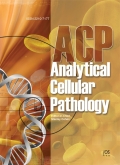Authors: Mazzucchelli, Roberta | Morichetti, Doriana | Santinelli, Alfredo | Scarpelli, Marina | Bono, Aldo V. | Lopez-Beltran, Antonio | Cheng, Liang | Montironi, Rodolfo
Article Type:
Research Article
Abstract:
Objective: The aim was to examine the expression and localization of the five somatostatin receptors (termed SSTR1–5) in radical prostatectomies (RPs) from patients with prostatic adenocarcinoma (PCa) under complete androgen ablation (CAA) before operation. Material: The five SSTRs were evaluated in the epithelial, smooth muscle and endothelial cells of normal-looking epithelium (Nep), high-grade prostatic intraepithelial neoplasia (HGPIN) and PCa in 20 RPs with clinically detected PCa from patients under CAA. 20 RPs with clinically detected PCa from hormonally untreated patients were used as control group. Results: Concerning the secretory cells (i) membrane staining was seen for SSTR3 and
…SSTR4; the mean percentages of positive cells, higher in SSTR3 than in SSTR4, decreased sharply in HGPIN and PCa compared with Nep; the mean percentages in the androgen ablated group were 30–90% lower than in the untreated; (ii) cytoplasmic staining was seen for all 5 SSTRs; the mean percentages of positive cells in Nep, HGPIN and PCa of the untreated group were similar, and in general as high as 80% or more; in the treated group, the Nep values were similar to those in the untreated, whereas the values in HGPIN and PCa were lower for SSTR1, 3 and 5, with a decrease of 30% for SSTR1; (iii) nuclear staining was seen with SSTR4 and SSTR5, the mean percentages for the former being much lower than for the latter; treatment affected both HGPIN and PCa, whose proportions of stained cells were 30–55% lower than in the untreated group. Cytoplasmic staining in the basal cells was seen for all 5 SSTRs, both in Nep and HGPIN. The values in the treated group were lower than in the other, the difference between the two group being in general comprised between 10 and 40%. Treatment did not affect SSTR staining in the smooth muscle and endothelial cells. Conclusions: The present study expands our knowledge on the expression and localization of the five SSTRs in the prostate following CAA.
Show more
Keywords: Somatostatin receptors, prostate cancer, high-grade prostatic intraepithelial neoplasia, complete androgen ablation
DOI: 10.3233/ACP-CLO-2010-0529
Citation: Analytical Cellular Pathology,
vol. 33, no. 1, pp. 27-36, 2010
Price: EUR 27.50





